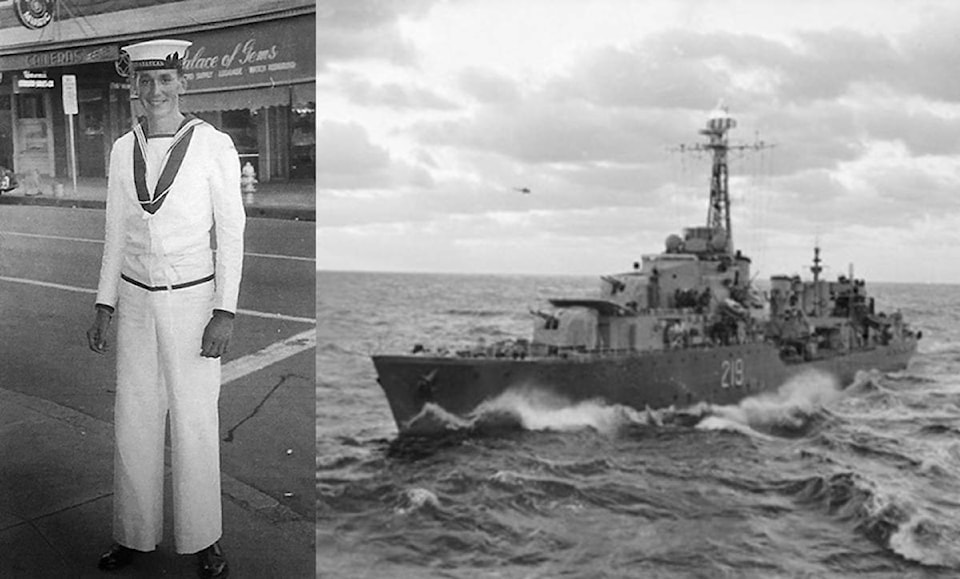Few people in Cranbrook have known the sea as well as Harry Ruppel has come to know it.
Ruppel’s career in the Royal Canadian Navy saw him serve on a dozen ships (mostly frigates and destroyers), visit or station in nine Canadian military bases, and visit more than 30 ports of call around the world, some of them many times.
Ruppel also served as leading seaman aboard Her Majesty’s Yacht Britannia during Queen Elizabeth’s Canadian Royal Tour in 1964.
Not to mention the Korean War.
After growing up in Summerland, Ruppel joined the Navy at age 20, following the footsteps of some friends to HMCS Cornwallis (now CFB Cornwallis) in Nova Scotia, in 1951. He went straight out of boot camp to the Korean War, sailing with the HMCS Athabaskan.
“They needed a lot of loading numbers and look-outs,” Ruppel said, speaking to the Townsman as Remembrance Day approached.
“But I was fortunate — they were short of signalmen, so I got to do that instead.”
The job of a loading number was to push the massive shells by hand into the breach of the ship’s turret-mounted guns. Signalmen, at the time, worked with flagging and light codes, semaphore and radio signals.
(After the Korean War, Ruppel would get into cryptography, and over his 2o-year career would be witness to the rapid technological changes in that specialty).
Ruppel’s first Korean tour of duty saw his ship patrolling off Korea’s west coast — although most of the action was on the east coast, he said.
Nonetheless, the Athabaskan was part of a sizeable flotilla, including the famous USS Missouri. Occasionally, squadrons of Communist MiG jet fighters would appear, or visible troop movements on the shore
The Athabaskan occasionally bombarded targets on the land, joined by other ships in the flotilla, like the Missouri. Their shells flying overhead sounded like a freight train, Ruppel said.
During the war, he would be at sea for 14 days at a stretch — sometimes 21.
After the war, Ruppel returned to HMCS Cornwallis for further training. “Coming back, everybody stayed on [with the navy],” he said.
And so Ruppel, who would for the next 20 years be based out of Esquimault, near Victoria, BC, resumed his life on the Pacific Ocean, first a return to Korea on the destroyer HMCS Crusader for peacekeeping operations, followed by years of patrols and cruises on the Pacific, including 1958’s famous Spring Cruise — his longest — from Esquimault to Hawaii (Ruppel stopped in Hawaii 13 times during his career) to Japan, down the coast of China to Vietnam, back through the Philippines to Hawaii, to San Diego, and back up the west coast to Esquimault.
“There is nothing as peaceful and soothing than being at sea on a calm evening with a beautiful sunset and the little waves lapping up against the hull, playing a sweet lullaby,” Ruppel wrote in 2017.
In 1964, Ruppel, now with rank of Leading Seaman, but at the moment “between ships,” received some special orders — to be among six Canadian seaman and an officer who would be part of the crew of Her Majesty’s Yacht Britannia on Queen Ellizabeth’s and Prince Phillip’s royal tour of the Maritimes and Quebec.
Flying to NATO base in France and thence to Portsmouth, England, the Canadians joined the Britannia and set sail across the Atlantic, a trip renowned for the heavy weather and storms they had to deal with.
“It was a rough trip,” Ruppel said. “It was like a typhoon.” He has the photographs to prove it.
Following the Royal Tour, the Queen returned from Canada to the UK, but the Royal Britannia sailed for points south, with Prince Phillip and his researcher friend on board, through the Caribbean and Panama Canal to the Galapagos Islands.
At that time, Ruppel said, the Galapagos Islands were still existing in isolation, without the tours and facilities for tourists one sees today. The unique birds and animals that exist there were practically tame, he added.
All told, Ruppel spent almost four months on board the Britannia.
Subsequent years saw Ruppel on board several ships, and taking officer training, achieving the rank of Warrant Officer. In 1967, he received the Centennial Medal for valuable service. Other awards Ruppel received include the Korean Medal, the Korean UN Medal, Canadian Decoration, United Nations Citation, and the President of Korea Citation.
In 1973, however, a mainland opportunity opened up — in Cranbrook, a civilian job with the RCMP, at the dispatch desk — and Ruppel decided to move his family inland.
Following a stint with his RCMP job in the Lower Mainland, Ruppel returned to Cranbrook, where he stayed, building a new career and a home after 20 years in the Navy.
But the sea is never far from his mind, or the ships that he sailed on.
“Newer ship with the most up-to-date equipment and living conditions. I pine to just have one opportunity to said on one,” he wrote just this year.
Harry Ruppel’s Ships:
• Athabaskan (destroyer)
• Ontario (cruiser)
• Beacon Hill (frigate)
• Crusader (destroyer)
• Settler (frigate)
• Fraser (destroyer — Ruppel served on this ship three times)
• Cowichan (minesweeper)
• Jonquiere (frigate)
• Royal Yacht Britannia
• Antigonish (frigate)
• Qu’Appelle (destroyer — Ruppel served on this ship two times)
• St. Croix (destroyer)
